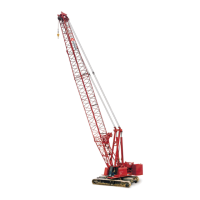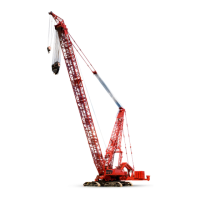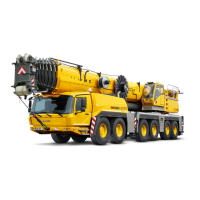Manitowoc Published 10-01-2012, Control # 045-08 1-11
777 SERVICE MANUAL INTRODUCTION
1
closed-loop circuit. In addition to oil slippage for the
prevention of excessive heat buildup, the 777 swing and
track motors incorporate an integral loop flushing (purge
valve) system consisting of control valve (29) and relief valve
(30). This loop flushing system allows 5 gpm (19 l/m) of oil at
350 psi (24 bar) to be removed from the main hydraulic
circuit for additional cooling and purification. When
pressurized by oil from the high pressure lines of motor ports
A or B, control valve shifts, initiating the flow of oil from the
low pressure side of the circuit through the control valve and
over relief valve (30) into the motor case.
The load drum motor circuits, like the swing and track motor
circuits, contain loop flushing (purge valve) systems; the loop
flushing valve is independent of the motor in each of the
motor circuits. The flushing valves allow 4 gpm (15.5 l/m) of
oil at 275 psi (19 bar) to be removed from the main hydraulic
circuit for additional cooling and purification.
Charge Pressure
The diagnostic display can be used to obtain information
about the system charge pressure. When a system handle is
in the neutral position, the system diagnostic screens
(DRUM 1, 2, and 8; BHST; SWING; and TRACK) can provide
this information (see Diagnostic Display in Section 10 of this
manual).
Charge pressure in each of the closed-loop systems is
established by setting the poppet-type relief valve in the
system’s charge pump. The charge pressure relief is preset
by the manufacturer at 350 psi (24 bar) and will maintain the
system pressure at a value greater or equal to this value
depending on engine rpm. The charge pressure must be at a
minimum of 120 to 150 psi (8 to 10 bar) for closed-loop
system pump operation to occur; lower pressures cause a
slowing or ceasing of system operation. When charge
pressure is low, the PC does not destroke closed-loop
system pumps.
If the rear load drum charge pressure pump would lower the
disc brakes for the rear load drum, swing, and travel
applications may begin to apply. The source of the brake
pressure for the front load drum and auxiliary hoist is from
their own respective charge pump. The brakes begin to
apply at about system pressure of 250 psi (17 bar) for the
load drums, auxiliary hoist (optional), and travel brakes, and
260 psi (18 bar) for the swing systems. The brakes are fully
applied at a system pressure of 190 psi (13 bar) for the load
drums and travel brakes, 220 psi (15 bar) for the swing brake
system, and about 165 psi (11 bar) for the auxiliary hoist
brake systems.
The charge pressure system of the rear hoist provides pilot
pressure to shift the servo cylinders of the rear hoist drum
and auxiliary hoist motors from maximum to minimum
displacement, and the travel motor from minimum to
maximum displacement. The front hoist charge pump
pressure also provides the pilot pressure to shift the servo
cylinder of the front hoist drum motor from maximum to
minimum displacement.
Main System Pressure
The diagnostic display can also be used to acquire
information about the main system pressure. When in use,
the system diagnostic screens (DRUM 1, 2, and 8; BHST;
SWING; and TRACK) can provide this information (see 777
Diagnostic Display in Section 10 of this manual). A more
accurate indication of system pressure an be obtained by
monitoring the diagnostic manifold with a high pressure
gauge (7,500 psi [517 bar] minimum) when the pump is
stroked. As previously described, the system pressure for
the load drum, boom, swing, travel, and auxiliary pumps is
controlled by one of two different configurations of
multifunction valve cartridges consisting of system relief and
pressure limiting valves. The pressure setting of the
multifunction valves for each pump is listed in Table 1-2. The
limits should not be reached unless there is a failure in these
systems.
This pressure limiting action prevents overheating of travel
system oil by reducing discharging flow rate through relief
valve feature of system multifunction valve.
The relief valve feature of the multifunction valves in all
system pumps protects the pump systems from damage by
limiting pressure above the system limits in each direction.
Accessory System Pressure
See Figures 1-7 and 1-8 for following procedures.
The crane setup hydraulic circuit is controlled through the
use of the 25.6 gpm (high idle) middle section of a tandem
gear pump called the accessory pump (1) and a mobile-type
valve called the lower accessory valve (3). The control valve
has parallel operating circuits and contains a relief valve (4)
pre-set at 3,100 psi (214 bar).
When moving a system handle to pressurize a valve section
in the setup system, the center flow-through passage of the
control valve is blocked, stopping oil flow to pilot-operated
check valve (5). The pressurized oil within the pilot cavity of
valve (5) exhausts to tank through bleed-off orifice (6) and
permits the valve to close. The flow output from accessory
pump (1) is no longer discharged to hot oil boom shuttle
valve (30) through check valve (5) but supplied to a function
of the lower accessory valve (3).
Hydraulic Supply
See Figure 1-8 for following procedures.
The hydraulic supply is maintained by accessory pump (1)
which provides 30 gpm of oil at 3,100 psi (215 bar) to all
setup system hydraulic cylinders and 60 gpm of oil at up to
100 psi (7 bar) maximum pressure to the filtration super
charge circuit. The super-charged oil is supplied to the
boom, swing, and travel pumps.

